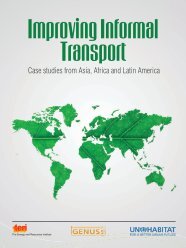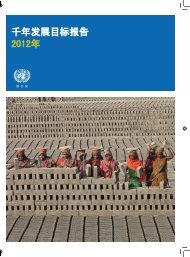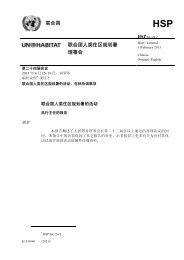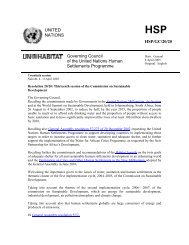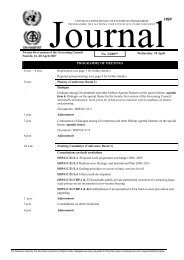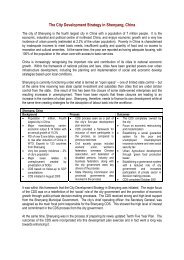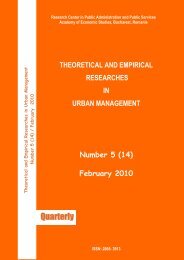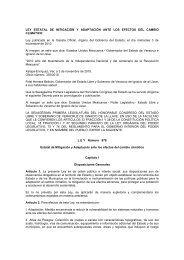Harmonious cities - UN-Habitat
Harmonious cities - UN-Habitat
Harmonious cities - UN-Habitat
Create successful ePaper yourself
Turn your PDF publications into a flip-book with our unique Google optimized e-Paper software.
COVER STORY China and India: a telling contrast<br />
43 percent urban, India only 30 percent. The<br />
rates of urban growth are 2.7 percent per year<br />
in China (going down towards two percent)<br />
and 2.4 percent in India (going up towards<br />
2.6 percent). At the start of the reform, in<br />
1985-90, the urban population of China was<br />
growing at the very high pace of five percent<br />
per year.<br />
If China has enormously urbanised during<br />
the last 20 years (in absolute terms the<br />
number of urban residents doubled, from<br />
288 to 577 million), India has also followed<br />
the same universal trend, but at a slower pace<br />
(urban increase from 205 to 350 million). In<br />
2030, according to <strong>UN</strong> projections, China<br />
should be 62 percent urban and India 41 percent.<br />
China is likely to reach the 50 percent<br />
urban threshold by 2016.<br />
Main features of the urbanisation<br />
process<br />
As far as the size of large <strong>cities</strong> is concerned,<br />
China and India are rather similar.<br />
The two countries have indeed the same<br />
number (eight) of <strong>cities</strong> of more than five million<br />
people. In China they are in 2008: Shanghai<br />
(15.3 million), Beijing (11.3), Guangzhou<br />
(nine), Shenzhen (7.8), Tianjin (7.3), Hong<br />
Kong (7.3), Wuhan (7.3) and Chongqing (6.6).<br />
14<br />
u r b a n<br />
WORLD<br />
November 2008<br />
In India, also in 2008: Mumbai (19.3), Delhi<br />
(16), Kolkata (15), Chennai (7.3), Bangalore<br />
(seven), Hyderabad (6.5), Ahmedabad (5.5)<br />
and Pune (five million in 2010). The parallels<br />
are striking: the two big ports in the<br />
lead, followed by the two capitals. The figures<br />
in parenthesis correspond to the physical<br />
agglomerations (the only pertinent ones<br />
for international comparisons) and are not<br />
related to administrative boundaries, which<br />
often include large rural territories (the Autonomous<br />
Municipality of Chongqing which<br />
gathers 32 million inhabitants over 82,300<br />
km 2 — it is de facto a ‘small’ province – and<br />
would be, by such an administrative definition,<br />
“the second most populous city in the<br />
world” after Tokyo!).<br />
It should be noted that the eight largest<br />
Indian <strong>cities</strong> are much better distributed on<br />
the national territory than their seven largest<br />
Chinese counterparts, all located in the<br />
eastern coastal region with the exception of<br />
Wuhan and Chongqing. In India the hexagon<br />
Delhi – Kolkata – Chennai – Bangalore<br />
– Mumbai – Ahmedabad nicely covers almost<br />
the entire country.<br />
In China, urbanisation intensity focuses<br />
primarily on three eastern corridors:<br />
those of the Bohai industrial region (Bei-<br />
jing – Tianjin – Tangshan) in the north, of<br />
the Changjiang/Yangtze delta (Shanghai –<br />
Nanjing – Hangzhou) in the centre and of<br />
the Zhujiang/Pearl River delta (Guangzhou<br />
– Shenzhen – Hong Kong) in the south. We<br />
may add two secondary corridors: the Shandong<br />
peninsula and the Yangtze valley. The<br />
extreme case of Shenzhen, a city whose population<br />
increased tenfold in two decades,<br />
illustrates the boom of the Special Economic<br />
Tianjin, with 7.3 million people, is one of many Chinese <strong>cities</strong> that has urbanised dramatically in the last 20 years Ph o t o © tu d o u mA o<br />
Zones and the magnitude of the migrations<br />
to the coastal provinces since the beginning<br />
of the economic reform in the 1980s. If<br />
it were a separate country, the Pearl River<br />
delta economic zone, with 65 million<br />
people, would be the world’s 18 th -largest<br />
economy and its 11 th -biggest exporter, ahead<br />
of India. According to The Economist, it<br />
has enjoyed an astonishing average annual<br />
growth rate of 17 percent for the past<br />
quarter century.<br />
In 2008, China had 100 <strong>cities</strong> with populations<br />
of one million or more, 140 <strong>cities</strong><br />
with more than 750,000 people and 670<br />
<strong>cities</strong> with more than 100,000 inhabitants<br />
while India counts only 35 million plus <strong>cities</strong><br />
(known as metro-<strong>cities</strong>), 57 <strong>cities</strong> above<br />
750,000 inhabitants and 400 <strong>cities</strong> above<br />
100,000 inhabitants.




